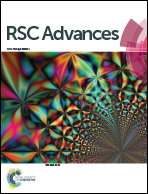Continuously tunable emission color based on the molecular aggregation of (2Z,2′Z)-2,2′-(1,4-phenylenae)bis(3-(4-(dodecyloxy)phenyl)acrylonitrile)†
Abstract
The development of organic solid-state luminescent materials with continuously tunable emission is a topic of interest for both fundamental research and practical applications. A luminescent liquid crystal, (2Z,2′Z)-2,2′-(1,4-phenylenae)bis(3-(4-(dodecyloxy)phenyl)acrylonitrile) (PDPA) is reported, which exhibits a continuously tunable emission color from green to orange at room temperature when cooled from an isotropic liquid at different cooling rates. PDPA self-assembles to a layer structure and/or a helical structure with different pitch length depending on the stacking rate, which influences the conformation coplanarity. The conjugation lengths shorten and the π–π interactions weaken, inducing a photoluminescence spectrum blue-shift from 600 nm to 506 nm; a considerable luminescent shift. Therefore, this material has potential uses in novel optical devices, as its emission profile can be tuned by controlling the molecular aggregation.


 Please wait while we load your content...
Please wait while we load your content...